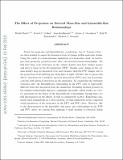| dc.contributor.author | Shetty, Rahul | |
| dc.contributor.author | Collins, David C. | |
| dc.contributor.author | Kauffmann, Jens | |
| dc.contributor.author | Goodman, Alyssa | |
| dc.contributor.author | Rosolowsky, Erik W. | |
| dc.contributor.author | Norman, Michael L. | |
| dc.date.accessioned | 2011-02-07T14:40:01Z | |
| dc.date.issued | 2010 | |
| dc.identifier.citation | Rahul, Shetty, David C. Collins, Jens Kauffmann, Alyssa A. Goodman, Erik W. Rosolowsky and Michael L. Norman. 2010. The Effect of Projection on Derived Mass-Size and Linewidth-Size Relationships. The Astrophysical Journal 712(2): 1049-1056. | en_US |
| dc.identifier.issn | 0004-637X | en_US |
| dc.identifier.uri | http://nrs.harvard.edu/urn-3:HUL.InstRepos:4706177 | |
| dc.description.abstract | Power-law mass-size and linewidth-size correlations, two of "Larson's laws," are often studied to assess the dynamical state of clumps within molecular clouds. Using the result of a hydrodynamic simulation of a molecular cloud, we investigate how geometric projection may affect the derived Larson relationships. We find that large-scale structures in the column density map have similar masses and sizes to those in the three-dimensional simulation (position-position-position, PPP). Smaller scale clumps in the column density map are measured to be more massive than the PPP clumps, due to the projection of all emitting gas along lines of sight. Further, due to projection effects, structures in a synthetic spectral observation (position-position-velocity, PPV) may not necessarily correlate with physical structures in the simulation. In considering the turbulent velocities only, the linewidth-size relationship in the PPV cube is appreciably different from that measured from the simulation. Including thermal pressure in the simulated line widths imposes a minimum line width, which results in a better agreement in the slopes of the linewidth-size relationships, though there are still discrepancies in the offsets, as well as considerable scatter. Employing commonly used assumptions in a virial analysis, we find similarities in the computed virial parameters of the structures in the PPV and PPP cubes. However, due to the discrepancies in the linewidth-size and mass-size relationships in the PPP and PPV cubes, we caution that applying a virial analysis to observed clouds may be misleading due to geometric projection effects. We speculate that consideration of physical processes beyond kinetic and gravitational pressure would be required for accurately assessing whether complex clouds, such as those with highly filamentary structure, are bound. | en_US |
| dc.description.sponsorship | Astronomy | en_US |
| dc.description.sponsorship | Other Research Unit | en_US |
| dc.language.iso | en_US | en_US |
| dc.publisher | American Astronomical Society | en_US |
| dc.relation.isversionof | doi:10.1088/0004-637X/712/2/1049 | en_US |
| dc.relation.hasversion | http://arxiv.org/abs/1001.4549v2 | en_US |
| dash.license | OAP | |
| dc.subject | ISM: clouds | en_US |
| dc.subject | ISM: structure | en_US |
| dc.subject | methods: analytical | en_US |
| dc.subject | stars: formation | en_US |
| dc.title | The Effect of Projection on Derived Mass-Size and Linewidth-Size Relationships | en_US |
| dc.type | Journal Article | en_US |
| dc.description.version | Author's Original | en_US |
| dc.relation.journal | Astrophysical Journal | en_US |
| dash.depositing.author | Goodman, Alyssa | |
| dc.date.available | 2011-02-07T14:40:01Z | |
| dc.identifier.doi | 10.1088/0004-637X/712/2/1049 | * |
| dash.contributor.affiliated | Goodman, Alyssa | |


